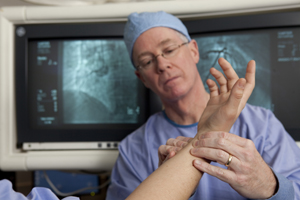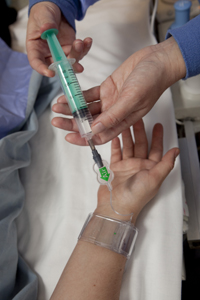Published: Synapse 2012, Vol. 1
The human heart is a mighty wonder. Weighing under a pound, it pumps away, moving 2,000 gallons of blood each day and delivering life-sustaining oxygen to every inch of the body, including its own muscle.
Like all organs, the heart needs blood to stay on the job. But, heart vessels may be narrowed by plaque buildup, and if a plaque suddenly ruptures and a clot forms (as occurs in a heart attack), a vessel may be blocked. In these situations, chest symptoms and findings on heart tests often lead cardiologists to perform heart catheterization.
 During the procedure, a thin tube is inserted into an artery in the groin or arm, and a catheter is threaded up the artery to the heart. Dye is injected so blood flow through the heart can be seen on an X-ray (angiography). If one or more coronary arteries is badly blocked and unreachable, the cardiologist may proceed directly to an intervention to restore blood flow, the most common being balloon angioplasty and stent placement. Restoring blood flow can relieve chest pain and other symptoms of coronary artery disease and, most importantly, can save a life or substantial heart muscle during a heart attack.
During the procedure, a thin tube is inserted into an artery in the groin or arm, and a catheter is threaded up the artery to the heart. Dye is injected so blood flow through the heart can be seen on an X-ray (angiography). If one or more coronary arteries is badly blocked and unreachable, the cardiologist may proceed directly to an intervention to restore blood flow, the most common being balloon angioplasty and stent placement. Restoring blood flow can relieve chest pain and other symptoms of coronary artery disease and, most importantly, can save a life or substantial heart muscle during a heart attack.
Taking a shorter route to the heart
Since late 2010, the interventional cardiologists at The Chester County Hospital have been taking a shorter path to the heart during catheter-based procedures. Rather than the standard route through a large artery in the groin, they are using a small artery in the wrist as the entry point whenever possible -- a technique called "radial artery access" or Transradial Access.
Although in existence for 20 years, the wrist technique was not embraced in the United States until recently. That trend is changing as research increasingly shows that the wrist approach is associated with fewer complications and a better patient experience.
Achieving better outcomes and higher patient satisfaction with cardiac catheterization procedures were major goals driving the Hospital's commitment to offer radial artery access.
"Safety was the overriding issue -- we saw that it was definitely safer to take the radial approach," says Interventional Cardiologist Joseph Lewis, MD, who is Medical Director for the Hospital's Interventional Peripheral Vascular Laboratory and a partner at Chester County Cardiology Associates. "But, it also is more comfortable and convenient for the patient," he adds.
Potential benefits the wrist approach
Serious heart complications are uncommon with cardiac catheterization, but major bleeding at the site where a catheter is inserted is an important preventable problem. Studies link major bleeding with higher rates of death, heart attack and stroke in the 30 days after a cardiac intervention. The risk of bleeding is higher when the femoral artery in the groin is used and when more medicines are prescribed to prevent clotting. Elderly patients, particularly women with a small frame or low body weight, also have a higher risk of bleeding.
 "Bleeding is a dangerous complication we need to avoid if at all possible," says Interventional Cardiologist Mian Jan, MD, Chairman of the Hospital's Department of Medicine, President of West Chester Cardiology and President of the Chester County Medical Society. He notes that a key benefit of the radial approach is a low potential for bleeding.
"Bleeding is a dangerous complication we need to avoid if at all possible," says Interventional Cardiologist Mian Jan, MD, Chairman of the Hospital's Department of Medicine, President of West Chester Cardiology and President of the Chester County Medical Society. He notes that a key benefit of the radial approach is a low potential for bleeding.
This was clearly shown in a recent international study in more than 7,000 patients undergoing cardiac interventions to restore blood flow to badly clogged heart vessels. The study, called RIVAL, compared the outcomes of taking a wrist versus groin approach and found that the wrist approach reduced the risk of major vascular access complications by 63%.
Why is bleeding risk lower? For one, says Dr. Jan, the radial artery -- which is the artery pressed when taking a pulse -- is easy to see and to compress because it sits on top of a bone. Therefore, bleeding from the radial artery is easier to control than bleeding from the femoral artery, which lies deeper in the body and is more difficult to compress. Furthermore, adds Dr. Jan, with the femoral artery, bleeding can occur deep inside the abdomen. "This is the most dangerous of all bleeding," he says.
Dr. Lewis agrees. "With the wrist, there is nowhere for blood to hide," he says. "If you are not getting adequate compression, you are going to know it immediately, not after a patient has lost a lot of blood."
After cardiac catheterization using the wrist approach, the sheath is removed and an inflatable band, similar to a bracelet, is placed over the puncture site to close it. With the groin approach, manual compression over the puncture site is necessary. In addition, patients need to lie in bed for at least two hours and often longer until the puncture site is closed, whereas they can sit up immediately after a radial procedure.
Dr. Lewis notes that RIVAL and other large studies suggest that the greatest benefits of a radial approach may be seen in people treated for an acute heart attack.
These studies show that when a cardiologist is experienced and comfortable treating an acute heart attack using the radial approach, not only is bleeding risk lower but there are fewer strokes, heart attacks and deaths in the 30 days following the procedure.
A strong endorsement from patients
Patient feedback on radial artery access cardiac catheterization has been overwhelmingly favorable. "Patients come in asking specifically for the wrist approach," says Dr. Lewis. "They may have heard about it from a friend or neighbor or had a previous procedure from the groin."
Kim White, Assistant Director of Invasive Cardiology at The Chester County Hospital, agrees that people who have experienced a femoral procedure previously have the most positive things to say about radial access. "They are the ones we hear from the most," she says. "They know that a femoral procedure can be more uncomfortable, particularly the need to lay flat for hours." She notes that people with back pain or other problems that make lying for a prolonged period difficult are much happier to have a radial procedure.
The wrist approach -- no turning back now
The number of radial procedures performed at The Chester County Hospital has increased steadily over the 15 months it has been used. In November 2010, 22% of the catheterbased procedures performed were done radially. In January 2012, 67% of the procedures performed used a radial approach.
"This ship has sailed," says Dr Jan. "We are 'married' to the radial artery now." He believes that as new catheters and smaller sheaths are developed for thinner arteries, the percentage of procedures done radially will increase even further.
Dr. Lewis is equally confident that the number and complexity of radial procedures that take place at The Chester County Hospital will continue to grow. "The Hospital is being very proactive. Our percentages are ever increasing, and our results have been excellent." During the 15 months we have performed radial procedures, there have been no reportable complications. Only two femoral site complications were reported in 2010.
Dr. Lewis says they are now treating patients in the throes of acute heart attacks radially and are comfortable with the procedure. "We have performed a few," he says, "and they went beautifully."
By Debra Dreger
Photos by Rick Davis
Radial Artery Access Advantages
- Lower risk of bleeding at the access site
- Less bruising and discomfort
- Faster recovery; patients can sit up immediately after the procedure and move around quicker
- No need to stop anticoagulant therapy (blood thinners), which may contribute to a lower risk of serious complications such as stroke
Limitations
- Not everyone is a candidate; a person without good blood flow through the other major artery to the hand or who has had bypass surgery involving the radial artery would not be a candidate
- Requires specialized training and experience on the part of the interventional cardiologist
- Venue challenges; the radial artery is prone to quirky anatomy and can be difficult to navigate, and its smaller size may not allow use of tools needed for some procedures
When to be concerned...
- If you have new or worsening symptoms that raise concern about the risk of a heart attack, or if a test such as a stress test suggests increased risk, here are questions to ask:
- Is cardiac catheterization the best next step in evaluating my risk for a heart attack? What are the potential benefits and risks of the procedure?
- Am I a candidate for a radial approach to catheterization? If not, why?
- Is the doctor who will be performing the catheterization equally experienced and comfortable with a radial approach as he or she is with a femoral approach?
- If the test shows I have blocked arteries, what is the next step?
- If there is more than one option for treatment, what factors determine which option is best for me?